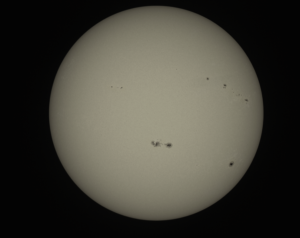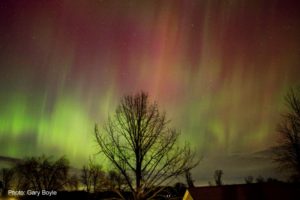by Gary Boyle – The Backyard Astronomer
Our daytime star is an enormous ball of hot plasma. Like a string of pearls, 109 earths line up side by side across its equator and 1.3 million of our worlds would fit inside. Ever since its birth some five billion years ago, the sun has been producing light we see and enjoy, via nuclear reactions deep in its core. The journey of a light photon is not a direct path to the surface but bounces around taking thousands to hundreds of thousands of years to reach the solar surface called the photosphere. Once it does, the photons travel in space unhindered to reach Earth 500 seconds later. They go on to light up the moon, planets and anything else in our solar system.
 This ball of super-hot material rotates at different speeds with its equatorial region spinning once every 25 days and a 35-day rotation close to the poles. Over the first half of its eleven-year solar cycle, the internal magnetic field twists, tangles and stretches like an elastic band. As the field lines intertwine, looking like tangled extension cords, they poke through the surface creating dark sunspots. These are cooler regions measuring 3,900 degrees Celsius compared to the surface temperature of 5,500 degrees Celsius. Eventually, the stored energy has to go somewhere.
This ball of super-hot material rotates at different speeds with its equatorial region spinning once every 25 days and a 35-day rotation close to the poles. Over the first half of its eleven-year solar cycle, the internal magnetic field twists, tangles and stretches like an elastic band. As the field lines intertwine, looking like tangled extension cords, they poke through the surface creating dark sunspots. These are cooler regions measuring 3,900 degrees Celsius compared to the surface temperature of 5,500 degrees Celsius. Eventually, the stored energy has to go somewhere.
Now magnetic field loops are seen rising from sunspots. Just like crossing two electrical wires resulting in a spark, these loops sometimes cross and produce a solar flare that rips off the photosphere, flying through space at hundreds of kilometres per second. Flares directed at Earth take about three days to travel 150 million kilometres and can produce very spectacular Northern Light aka the Aurora Borealis. Another source of Northern Lights is the opening in the sun called Coronal Mass Ejections (CMEs). These billion-ton clouds of charged particles belch out of the sun and fly through space at up to 3,000 kilometres per second in rare cases.
Solar max or the highest amount of solar activity is expected to peak in July 2025. Over the past few months, aurora activity has increased producing mid-range M-class flares and could, in the not-too distant future, produce more severe X-class flares. Once the sun reaches solar max, it should begin to wind down its activity for another five to six years to reach solar minimum with no sunspots visible. The sun will look like a white billiard ball with zero sunspots seen. A good source to follow the goings on with our daytime star is spaceweather.com which is linked to my website.
Although sunspots can measure many times the size of the earth and be seen by the “naked-eye”, that does not mean that you can look at the sun directly. Approved solar filters of number 14 welder’s glass will protect you from serious eye injury or even blindness. Although cell phone cameras are great for daytime images, they are improving for nighttime use.
 DSLR cameras are still the best way to image the Northern Lights. Place the camera with a wide- angle lens on a sturdy tripod and attach a cable release. Advance to ISO 1600 (light sensitivity) or higher. Set the lens on manual and focus it on a very bright star or distant light source until it is a pinpoint. Now you can take 8, 12 or 15-second images by triggering the cable release. This prevents touching the camera. Words cannot describe witnessing the aurora firsthand. These will be moments you will never forget.
DSLR cameras are still the best way to image the Northern Lights. Place the camera with a wide- angle lens on a sturdy tripod and attach a cable release. Advance to ISO 1600 (light sensitivity) or higher. Set the lens on manual and focus it on a very bright star or distant light source until it is a pinpoint. Now you can take 8, 12 or 15-second images by triggering the cable release. This prevents touching the camera. Words cannot describe witnessing the aurora firsthand. These will be moments you will never forget.
Known as “The Backyard Astronomer”, Gary Boyle is an astronomy educator, guest speaker, monthly columnist for the Royal Astronomical Society of Canada as well as a STEM educator. He has been interviewed on more than 55 Canadian radio stations as well as television across Canada and the U.S. In recognition of his public outreach in astronomy, the International Astronomical Union has honoured him with the naming of Asteroid (22406) Garyboyle. Follow him on Twitter: @astroeducator, Facebook and his website: www.wondersofastronomy.com.



